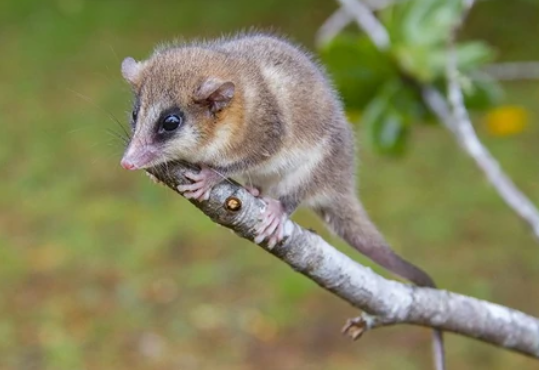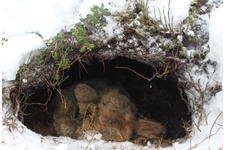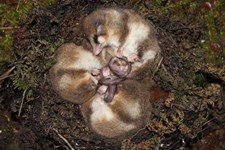Case studies

Star-Oddi Physio-Loggers Used to Detect Torpor and Hibernation
Star-Oddi physio loggers have been used to study torpor and hibernation for over a decade in numerous animal models, from small marsupials to large brown bears.
Torpor studies in small marsupials
One animal model is the tiny marsupial, monito del monte (Dromiciops gliroides) [1-3], that weighs in and around 25g. Torpor bouts were detected in both laboratory settings and in the field. In one study, torpor was not only detected in winter but also during warm summer days. An overview of the study can be found here.
Body temperature down to 5°C detected
The scientists studying the monitos were able to detect body temperature down to 5°C ±0.1°C during torpor using either the DST nano-T or the DST micro-T temperature loggers. From that they could calculate torpor parameters and metabolic rates in euthermia and torpor.
No clear circadian rhythm with ambient temperature of 24°C
Shrews have been studied for a long time in torpor and hibernation studies, mostly in ecophysiology context. In this study of the house musk shrew (Suncus murinus) using the DST micro-T scientists found that the ambient temperature of 24°C induced torpor but no clear circadian rhythm was seen.
Entrance and arousal from torpor detected with real time monitoring
For small mammals such as the shrew our real time monitoring telemetry system for laboratory housed animals facilitates easy detection of when the animal is waking up from torpor. Then clinical procedures such as blood or tissue sampling can be performed at the appropriate time. The telemetry system has been used successfully in various animal models such as mice, hamsters, marsupials, shrews and 13-lined ground squirrels with either DST nanoRF-T or DST microRF-T loggers.
Body temperature measured for over a year in bear hibernation studies
Hibernation studies have been performed on large bears [6-12] for several years using the DST centi-T logger. These studies can last for more than a year and by using the centi-T the scientist can choose a variety of measurement intervals and still have a long battery lifetime lasting for years.
Recent publication by Thiel et al. [10] for example showed how snow depth covering the dens influences body temperature during hibernation and an overview of that study can be found here.
Heart rate recorded with leadless loggers over several months in the wild
Heart rate in the Asian black bears [8] was shown to be higher than in their cousin the Eurasian brown bears during fattening season. In this study, heart rate was recorded during summer until the bears entered hibernation with the use of the DST milli-HRT logger, and heart rate in the Asian bear was lower until they reach the hyperphagic period.
In another study heart rate and temperature was measured using the DST micro-HRT in Squirrel gliders [13] throughout a year, detecting torpor during all seasons. The ability to measure heart rate alongside the body temperature gave the scientists insight into what happened in these tiny creatures during water and energy conservation.
Ongoing studies using activity in combination with temperature and heart rate
Our most recent product series is the activity series that comes in combination with either temperature (micro-, milli-, centi-ACT) or both temperature and heart rate (milli-, centi-HRT ACT). These two series are generating great data soon to be published.
Want more information?
For further information on logger sizes, weight and other specifications visit our physio-loggers product page or send us an email at star-oddi@star-oddi.com
Publications on torpor / hibernation – studies using our loggers
[1] Nespolo R, Mejías C, Espinoza A, Quintero-Galvis J, Rezende EL, Fanúrbel FE, Bozinovic F. Heterothermy as the Norm, Homeothermy as the Exception: Variable Torpor Patterns in the South American Marsupial Monito del Monte (Dromiciops gliroides). Frontiers of Physiology Vol. 12 (1026) July 2021.
[2] Roberto F. Nespolo, Isabella Peña, Carlos Mejías, Abel Ñunque, Tomás Altamirano, Francisco F. Bozinovic; Communal nesting is the optimal strategy for heat conservation in a social marsupial: lessons from biophysical models. J Exp Biol November 2022; 225 (22): jeb244606
[3] Mejías C, Navedo JG, Sabat P, Franco LM, Bozinovic F, Nespolo RF. Body Composition and Energy Savings by Hibernation: Lessons from the South American Marsupial Dromiciops gliroides. Physiological and Biochemical Zoology (2022) Vol.95 (3).
[4] Zhang, Z., Reis, F.M.C.V., He, Y. et al. Estrogen-sensitive medial preoptic area neurons coordinate torpor in mice. Nat Commun 11, 6378 (2020).
[5] Horii Y, Okadera K, Miyawaki S, Shiina T, Shimizu Y. Suncus murinus as a novel model animal that is suitable for elucidating the mechanism of daily torpor. Biomedical Research (2022) 43 (2) 53-57.
[6] Evans AL, et al. Drivers of hibernation in brown bear. Frontiers in Zoology (2016) 13:7.
[7] Friebe A, et al. Factors Affecting Date of Implantation, Parturition, and Den Entry Estimated from Activity and Body Temperature in Free-Ranging Brown Bears. PloS ONE (2014) 9(7): e101410
[8] Fuchs B, et al. Heart rate during hyperphagia differs between two bear species. Biology Letters, (2019)
[9] Lemière L, Thiel A, Fuchs B,Gilot-Fromont E, Hertel AG, Friebe A,Kindberg J, Støen O-G, Arnemo JM and Evans AL Extrinsic and intrinsic factors drive the timing of gestation and reproductive success of Scandinavian brown bears. Front. Ecol. Evol. (2022) 10:1045331.
[10] Thiel A, Giroud S, Hertel AG, Friebe A, Devineau O, Fuchs B, Blanc S, Støen O-G, Laske TG, Arnemo JM and Evans AL. Seasonality in Biological Rhythms in Scandinavian Brown Bears (2022). Front. Physiol. 13:785706.
[11] Evans AL, et al. Physiological reactions to capture in hibernating brown bears. Conservation Physiology (2016), vol 4
[12] Le Grand L, et al. Behavioral and physiological responses of Scandinavian brown bears (Ursus arctos) to dog hunts and human encounters. Frontiers in Ecology and Evolutions, (2019). Vol. 7.
[13] Dausmann K, Körtner G, Ahron-Rotman Y, Currie SE and Geiser F. Flexible Employment of Torpor in Squirrel Gliders (Petaurus norfolcensis): An Adaptation to Unpredictable Climate? Physiological and Biochemical Zoology (2022)

